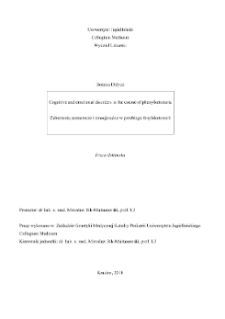Object
Title: Cognitive and emotional disorders in the course of phenylketonuria
Abstract:
Since the 1950s, the dietary restriction of the supply of phenylalanine in the diet of phenylketonuria still remains the basic treatment that should be rigorously applied throughout life. The effectiveness of therapy, high during infancy and early childhood, decreases at a later age due to rigor and nuisance. Unfortunately, despite many years of research into phenylketonuria, an effective strategy for the early discovery of discrete brain dysfunction in adolescents and young adults with phenylketonuria, which seems to be necessary, has not yet been developed.The aim of the study was to assess the effect of high levels of phenylalanine in the blood (resulting from inadequate treatment efficacy) on the occurrence of cognitive functions, neuropsychological disorders and emotional disorders in adolescents and young adults with phenylketonuria and clinical usefulness of selected diagnostic methods in early detection of the above disorders.Materials and methods: We analyzed the metabolic profile of a group of 70 patients with phenylketonuria, aged 12-19 years, treated at the Clinic of Metabolic Diseases at the University Children's Hospital in Krakow. For all patients described in works 1, 2 and 3, metabolic profiles were created from the neonatal period to inclusion in the study. The severity and variability of hyperphenylalaninemia was correlated with the assessment of cognitive fu ; nctions (Wechsler's Intelligence Scale), neuropsychological disorders (d2 and Benton tests), emotional (STAI test) and quality of life (General Psychological Well-Being Index) of patients (performed by clinical psychologist).Conclusions: The most useful parameters for both metabolic control in children and predicting the occurrence of brain dysfunction in adolescents with phenylketonuria appear to be the average of mean annual blood phenylalanine levels and the percentage of normal phenylalanine control results. The usefulness of selected diagnostic tools to detect neuropsychological and emotional disorders in adolescents and the quality of life in adult patients with phenylketonuria has also been demonstrated. Obtained results can be used in clinical practice to improve procedures for monitoring the effectiveness of treatment and increasing the safety of patients with phenylketonuria.
Place of publishing:
Level of degree:
Degree discipline:
pediatria ; genetyka ; psychiatria
Degree grantor:
Promoter:
Date issued:
Identifier:
Call number:
Language:
Access rights:
Object collections:
Last modified:
Dec 27, 2024
In our library since:
Jul 9, 2019
Number of object content hits:
194
Number of object content views in PDF format
0
All available object's versions:
http://dl.cm-uj.krakow.pl:8080/publication/4301
Show description in RDF format:
Show description in OAI-PMH format:
| Edition name | Date |
|---|---|
| ZB-129170 | Dec 27, 2024 |
Objects
Similar
Didycz, Bożena
Kowalska, Katarzyna Olga
Datka, Wojciech
Mączka, Grzegorz
Droś, Jakub
Pastuszak-Draxler, Anna
Epa, Roksana
Przybylska-Just, Joanna

